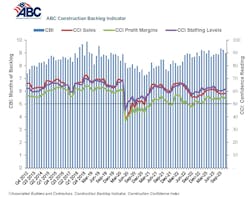Latest from Construction Data
Sponsored
WASHINGTON, DC — Associated Builders and Contractors reported today that its Construction Backlog Indicator declined to 9.0 months in September, according to an ABC member survey conducted Sept. 20 to Oct. 4. The reading is equivalent to one year ago.
View ABC’s Construction Backlog Indicator and Construction Confidence Index tables for September. View the full Construction Backlog Indicator and Construction Confidence Index data series.
Though it declined last month, the South continues to have the lengthiest backlog, which has been the case since October 2021. Over the past year, only the West has experienced increasing backlog.
ABC’s Construction Confidence Index reading for sales and staffing levels edged higher in September. The profit margins reading fell slightly. All three readings remain above the threshold of 50, indicating expectations for growth over the next six months.
“Construction continues to defy the downward gravitational pull of tightening credit conditions,” said ABC Chief Economist Anirban Basu. “Despite high and rising project financing costs, ABC contractor members continue to report lofty backlog, rising employment, expanding sales and stable profit margins.
“That said, industry headwinds grow in force,” said Basu. “Interest rates are still edging higher. Political dysfunction in Washington persists. Rising worker compensation costs and lingering supply chain issues are still frustrating industry performance and profitability. The US economy appears poised to slow further. If the past is any indication, that will eventually catch up to construction in the form of dissipating demand. But economists have talked about recession for more than a year, and the industry still shows substantial forward momentum. It remains to be seen whether that momentum can survive the latest set of challenges.”
Visit abc.org/economics for the Construction Backlog Indicator and Construction Confidence Index, plus analysis of spending, employment, job openings and the Producer Price Index.



